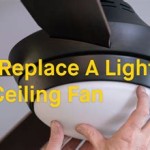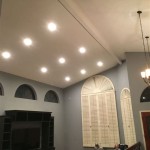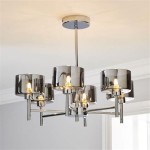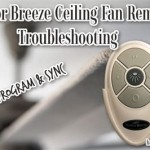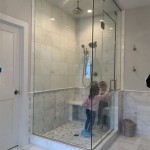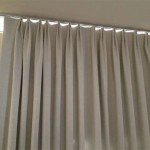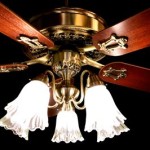How To Mount a Ceiling Fan On a Slanted Ceiling
Mounting a ceiling fan on a slanted or sloped ceiling presents unique challenges compared to a standard flat ceiling installation. The primary concern is ensuring the fan hangs vertically to operate safely and efficiently. This requires specialized hardware and a careful understanding of the installation process. This article will outline the steps involved in safely and correctly mounting a ceiling fan on a slanted ceiling, covering essential tools, safety precautions, and best practices.
Before commencing any electrical work, it is imperative to disconnect the power supply to the designated circuit at the electrical service panel (breaker box). This prevents the risk of electric shock during the installation process. Verify that the power is off using a non-contact voltage tester on the wires that will be worked on. It is also important to thoroughly review the ceiling fan's instruction manual, as specific models may have particular requirements or recommendations for sloped ceiling installations.
Key Point 1: Assessing the Slop Angle and Selecting the Appropriate Mounting Hardware
The first crucial step is to determine the angle of the ceiling slope. This measurement is critical for selecting the correct downrod and mounting bracket. Typically, ceiling fan manufacturers offer downrods and mounting brackets specifically designed for various degrees of slope. Using the wrong hardware can result in the fan hanging at an improper angle or, worse, putting undue stress on the mounting system, leading to potential failure. A standard level and an angle finder or protractor can be used to accurately measure the ceiling's slope. Place the level against the ceiling and then use the angle finder to measure the angle between the level and the ceiling's surface. It's often useful to measure the angle in several places to confirm consistency.
Once the slope angle is determined, consult the ceiling fan’s documentation or the manufacturer’s website to identify the appropriate downrod and mounting bracket. Downrods for sloped ceilings are typically longer than standard downrods to ensure adequate clearance between the fan blades and the ceiling. The mounting bracket will also be designed to accommodate the angle, providing a secure and level mounting surface. Some brackets are universal and adjustable for a range of angles, while others are designed for a specific slope. Choosing a bracket that is within the tolerance of the measured slope angle is crucial for a secure and balanced installation.
In addition to the angle, consider the weight of the ceiling fan and the structural integrity of the mounting location. Heavier fans may require additional reinforcement to the ceiling joist. Ensure the electrical box is rated to support the fan's weight. If the existing electrical box is not rated for fans, it must be replaced with a fan-rated box that is securely attached to the ceiling joist.
During the hardware selection process, consider the aesthetic impact. Longer downrods may be required for steeper slopes, which can affect the overall appearance of the fan in the room. Choose a downrod finish that complements the fan's design and the room's decor. The goal is to achieve both a safe and visually pleasing installation.
Key Point 2: Installing the Mounting Bracket and Wiring
After selecting the correct hardware, the next step involves installing the mounting bracket. Start by locating the ceiling joist where the fan will be mounted. Using a stud finder can help to accurately locate the joist. Confirm the location by drilling a small pilot hole and checking for solid wood. The mounting bracket must be securely attached to the joist to support the fan's weight and prevent wobbling. If the existing electrical box is not directly aligned with the joist, a mounting bar may be needed to bridge the gap.
With the joist located, attach the mounting bracket according to the manufacturer’s instructions. Use lag screws or wood screws of appropriate length and diameter to securely fasten the bracket to the joist. Ensure the bracket is level and properly aligned. For sloped ceilings, the bracket may have a swivel or ball-joint mechanism that allows the fan to hang vertically even with the angled mounting surface. Tighten all screws securely, but avoid over-tightening, as this can strip the screws or damage the joist.
Once the mounting bracket is securely installed, the electrical wiring can be connected. Carefully strip the insulation from the ends of the wires protruding from the electrical box and the wires coming from the ceiling fan. Connect the wires using wire connectors (wire nuts) according to the following standard color code:
- Black wire (hot) from the ceiling to the black wire from the fan motor.
- White wire (neutral) from the ceiling to the white wire from the fan motor.
- Green or bare copper wire (ground) from the ceiling to the green or bare copper wire from the fan motor and to the grounding screw on the mounting bracket.
Ensure all wire connections are secure and properly insulated. Carefully tuck the wires into the electrical box, taking care not to pinch or damage them. Proper wiring is essential for the safe and reliable operation of the ceiling fan. Double-check all connections before proceeding to the next step.
At this stage, it's advisable to use a multimeter to verify that there is no short circuit between the hot, neutral, and ground wires. This simple test can prevent damage to the fan motor or the electrical system.
Key Point 3: Assembling and Hanging the Fan Motor
With the mounting bracket installed and the wiring connected, the next step is to assemble and hang the fan motor. This typically involves attaching the downrod to the fan motor housing. Feed the motor wires through the downrod and connect them to the appropriate terminals inside the motor housing. The specific wiring configuration will vary depending on the fan model, so refer to the manufacturer’s instructions. Secure the downrod to the motor housing using the provided screws or bolts. Ensure the connection is tight and secure.
Once the downrod is attached, carefully lift the fan motor and insert the downrod into the mounting bracket. If the bracket has a ball-joint mechanism, ensure the ball is properly seated in the bracket. Secure the fan to the bracket using the provided locking pins or screws. The exact method will depend on the design of the mounting bracket. Make sure the fan is securely attached and cannot be easily dislodged.
After the fan motor is hanging securely, attach the fan blades according to the manufacturer’s instructions. This usually involves screwing the blades to the blade holders, which are then attached to the motor housing. Ensure all screws are tightened securely. Repeat this process for each fan blade. Properly balanced fan blades are crucial for smooth and quiet operation. If the fan wobbles excessively after installation, it may be necessary to use a balancing kit to adjust the blade weights.
Next, install the light kit, if the fan includes one. Connect the light kit wires to the appropriate terminals on the fan motor. Ensure all connections are secure and properly insulated. Attach the light fixture according to the manufacturer’s instructions. Test the light kit to ensure it is working correctly.
Finally, install the fan blade covers (if included) and the canopy that covers the mounting bracket and wiring. The canopy should fit snugly against the ceiling, concealing the electrical box and wires. Secure the canopy using the provided screws. This provides a clean and finished look to the installation. Ensure the canopy is properly aligned and does not interfere with the fan's operation.
Once the fan is fully assembled, restore power to the circuit at the electrical service panel. Test the fan to ensure it is running smoothly and quietly. Check all fan speeds and light functions. If the fan wobbles excessively, use a balancing kit to adjust the blade weights. Refer to the manufacturer’s instructions for balancing procedures.
Properly installing a ceiling fan on a slanted ceiling requires careful planning, the correct hardware, and adherence to safety precautions. By following these steps, a safe and functional installation can be achieved, enhancing the comfort and aesthetics of the room.

How To Install A Ceiling Fan On Sloped Lemon Thistle

Electrical Mount Ceiling Fan At The Peak Of A Sloped Home Improvement Stack Exchange

How To Install A Ceiling Fan On Sloped Lemon Thistle

Install Ceiling Fan On Sloped Simple Modern Handmade Home
How To Install A Ceiling Fan On Vaulted Quora

How To Choose A Ceiling Fan For Vaulted Ceilings Lightology

Ensuring Proper Ceiling Fan Installation With Vaulted Ceilings

Mounting Ceiling Fan On Sloped Home Improvement Stack Exchange

How To Install Vaulted Ceiling Fan

Fans On An Angle Installing Ceiling Angled Or Raked
Related Posts


